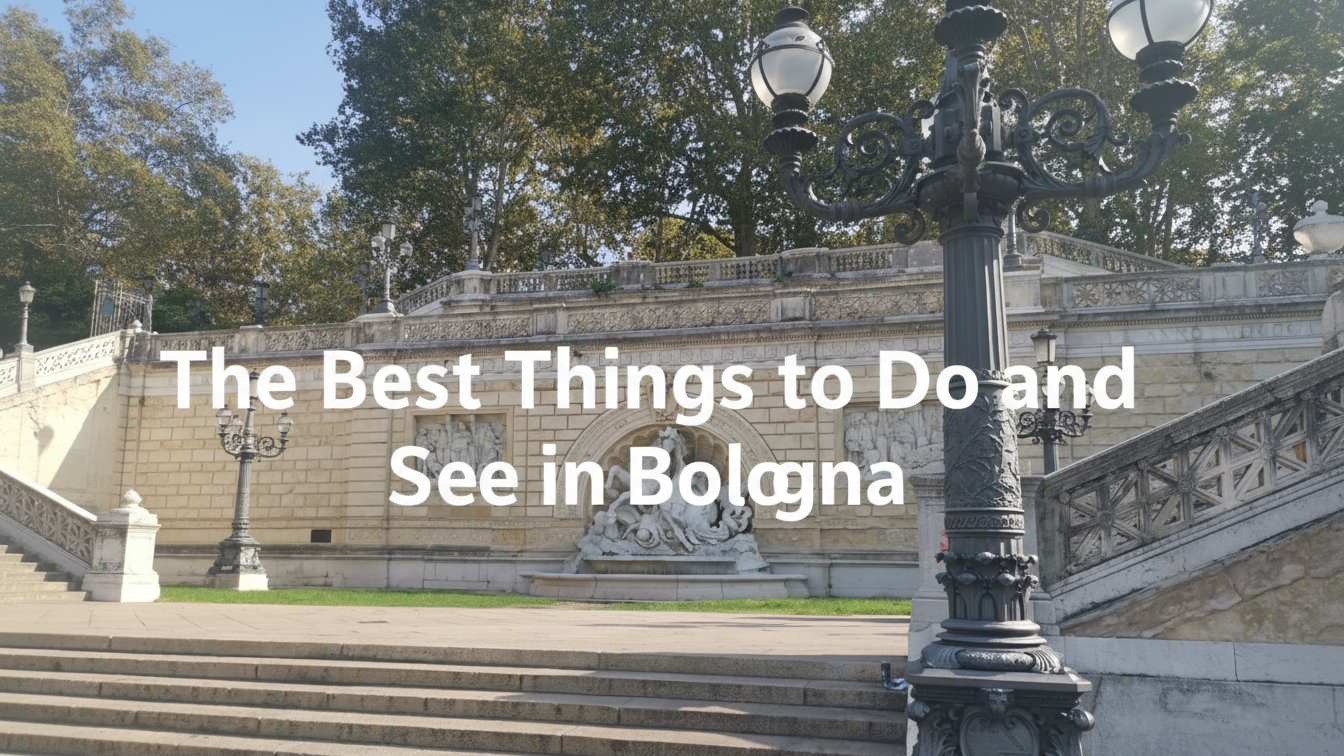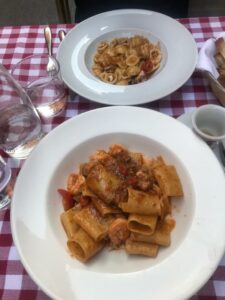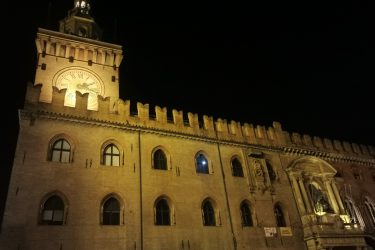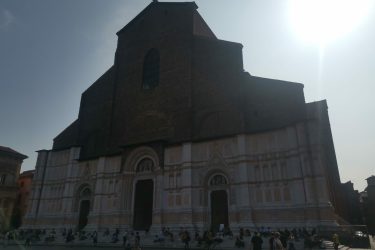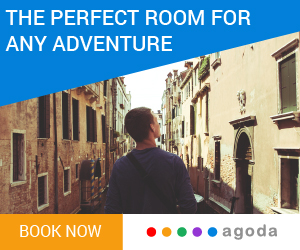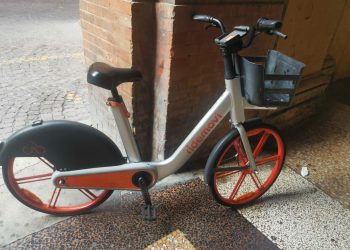Bologna, also known as “La Dotta” (The Learned) due to its medieval university, “La Grassa” (The Fat) due to its outstanding cuisine, and “La Rossa” (The Red) due to its terracotta rooftops, is a historic city tucked away in the northern Italian region. Here is a list of the main factors that make Bologna a fascinating city:
Cultural Center: The University of Bologna, which was established in 1088, is one of the oldest and most prominent academic institutions in the entire world. The city has a rich intellectual and cultural history, and its historic core is a UNESCO World Heritage Site that is home to numerous architectural treasures from the Renaissance and the Middle Ages.
Gastronomic Delights: Bologna is well known for its cuisine. Tortellini, mortadella, and Bolognese sauce (ragù) are all products of this region. Fresh produce, cheeses, meats, and other foods are available at local markets like Mercato di Mezzo and Quadrilatero, which are heaven for foodies.
Asinelli and Garisenda, the city’s two towers, are a representation of Bologna’s medieval past. The Asinelli Tower can be climbed for sweeping views of the city.
Vibrant Ambience: Piazza Maggiore, the city’s central plaza, is a center of activity thanks to the gorgeous Fountain of Neptune and the towering Basilica di San Petronio. The square is bustling with activity, from cultural events to street entertainers.
Bologna has a variety of cultural gatherings and festivals, such as the Bologna Children’s Book Fair and the famed Cinema Ritrovato film festival, which focuses on the rediscovery of classic cinema.
Bologna is a city of contrasts, where modernism and history peacefully coexist. Travelers wanting a taste of genuine Italy will find it to be a riveting destination thanks to its rich cultural heritage, mouth-watering cuisine, and bustling atmosphere.
In this article, we will give you the best things to do and see in Bologna.
Take a Bologna Food Tour
A Bologna food tour is a culinary journey that lets you sample the city’s culinary specialties and take in its vibrant food scene. A sample of what to anticipate when starting on this delicious adventure is given below:
Bologna, often known as “La Grassa” (The Fat), is famed for its delicious cuisine. An array of flavors are promised on a food tour here, from hearty pasta dishes like tagliatelle al ragù (Bolognese sauce) to savory cured meats and decadent gelato.
Local Expertise: skilled hosts who are enthusiastic about the region’s culinary history frequently lead Bologna food excursions. They exchange knowledge about the origins, components, and cooking methods of Bolognese cuisine.
Visit Local Markets: You’ll have the chance to stroll through vibrant food markets like the Quadrilatero, where you can taste local cheeses, handcrafted goods, and fresh fruit. An enriching aspect of the experience is talking to local sellers and discovering local ingredients.
Taste Traditional cuisine: Food excursions frequently include stops at classic trattorias, osterias, and family-run eateries where you may sample traditional Bolognese cuisine made in accordance with age-old recipes.
Wine Pairings: Do not forget to sample the superb wines produced in the area. Wine tastings are frequently included in food tours in Bologna, allowing you to enjoy regional vintages that go perfectly with the cuisine.
Discover Hidden Gems: Beyond the well-known dishes, food tours frequently unearth lesser-known restaurants and hidden culinary treasures that locals like.
A Bologna food tour takes you on a journey through the history, culture, and customs of the city in addition to gratifying your appetite. It is a wonderful chance to experience Bologna’s delectable cuisine first-hand and get a greater appreciation for it.
Stroll around Piazza Maggiore in Bologna
Bologna’s Piazza Maggiore, a storied and energetic plaza that is the center of the city and a focal point for both locals and tourists, is situated in the center of the city. Piazza Maggiore is a must-see destination in Bologna since it is surrounded by important architectural landmarks and is steeped in history.
The imposing Basilica di San Petronio, one of the biggest churches in Europe and a masterpiece of Gothic and Renaissance architecture, dominates the Piazza. It is a striking sight, with exquisite sculptures and ornate accents adorning its façade.
Elegant mediaeval and Renaissance structures, such as the City Hall (Palazzo d’Accursio), Town Hall (Palazzo Comunale), Palazzo del Podesta, Palazzo Re Enzo, and Palazzo Fava, round the area. These buildings serve as a testament to the city’s rich architectural and historical heritage.
The open area of Piazza Maggiore frequently hosts a variety of events, cultural festivals, and gatherings, fostering a vibrant and energetic atmosphere. Visitors can unwind on the Neptune Fountain steps or sip coffee at a neighboring café as they take in the sights of this busy square.
Piazza Maggiore in Bologna is a must-visit location, offering a rich tapestry of experiences in the center of the city, whether you’re interested in history, architecture, or simply soaking up the dynamic ambiance of a busy Italian square.
The Two Towers (Due Torri) in Bologna
The Two Towers, or “Due Torri” in Italian, are one of Bologna’s most well-known and recognizable sights, serving as a reminder of the city’s rich history and mediaeval roots. Visitors simply must see the Asinelli and Garisenda towers, which have adorned the city’s skyline for generations.
The Asinelli Tower is the higher of the two, rising to a height of about 97 meters (318 ft). You can get sweeping views of Bologna and the surrounding area by ascending its 498 wooden stairs. The city’s terracotta rooftops, old structures, and the distant Apennine Mountains may all be seen from this unusual vantage point. The Asinelli Tower has a slight slant, which increases its allure and mystique.
The Garisenda Tower is a little shorter and leans more drastically; it is around 48 metros (157 feet) tall. It is not accessible to the general public for climbing because to safety concerns. However, a strong visual contrast is produced by its unusual tilt and near proximity to the Asinelli Tower.
Both towers were built in the 12th century and performed a variety of functions, including defense and serving as representations of the strength and renown of aristocratic families. They provide a window into the city’s mediaeval past and serve as a tribute to Bologna’s rich historical and architectural legacy. When you visit the Two Towers, you may take a trip through time and take in the timeless beauty of Bologna’s skyline.
Hop on Hop off Bus Tours in Bologna
Bologna hop-on-hop-off bus excursions are an excellent way to see this ancient Italian city at your own speed. These trips provide an easy and adaptable way to explore Bologna’s numerous sites. What to anticipate from a standard Bologna hop-on-hop-off bus tour is as follows:
Easy Transportation: Well-designed routes that pass through the majority of Bologna’s main attractions and sites are covered by hop-on-hop-off buses, which offer a hassle-free way to get around the city.
Uninterrupted Sightseeing: Take in a never-ending loop of Bologna’s most popular sights while listening to educational commentary in several different languages. This lets you discover more about the history and culture of the city as you explore.
Flexibility: Being able to get off at any stop and visit the locations that most interest you is the main benefit. You can take as much time as you like at the Santo Stefano Complex, the Two Towers, or Piazza Maggiore before resuming the tour whenever it suits you best.
All-Inclusive Ticket: These tours usually provide one-day or multi-day passes that grant entry to every route. This makes it an affordable option to take in the attractions of Bologna.
Comfort and Dependability: Air-conditioned buses that are modern and have open-top alternatives provide tourists a comfortable and dependable way to get about.
Hop-on-hop-off bus excursions are an excellent way to make the most of your trip while in Bologna, regardless of how long you have to spend there.
Archiginnasio of Bologna
In the center of the city, the Archiginnasio of Bologna is a piece of architectural art and a historical treasure. This magnificent building, which was constructed in the late 16th century and functioned as the University of Bologna’s main building for many years, is an integral element of the city’s cultural and educational heritage.
The façade of the Archiginnasio is a magnificent example of Renaissance architecture and is embellished with lovely sculptures and ornaments made of terracotta. Visitors are primarily drawn in by the interior, though. The Teatro Anatomico, a magnificent anatomical theatre where medical students formerly watched dissections, is the centerpiece. Wooden layers, exquisite carvings, and a central dissecting table in the theatre are works of art and historical significance.
The coats of arms of former university professors cover the walls of the Archiginnasio, giving the building a distinguished intellectual aura. The structure also contains the Biblioteca Comunale dell’Archiginnasio, a library with a collection of antiquarian literature and rare manuscripts.
The Archiginnasio, which is available to the public, stands as a tribute to Bologna’s illustrious academic legacy today. Visitors can stroll through its storied halls, marvel at the anatomical theatre, and delve into the city’s illustrious intellectual past. It’s a must-see attraction for anyone hoping to discover Bologna’s cultural gems.
Nightlife in Bologna
The nightlife in Bologna is an exciting and bustling atmosphere that appeals to a wide variety of interests and inclinations. Bologna provides a nightlife experience that is both culturally rich and cutting edge as a city renowned for its historical past, world-class cuisine, and booming student population.
Bologna is home to a vast variety of nightclubs and pubs that cater to various musical genres and ambiances. There is something for everyone, from hot jazz clubs to intimate wine bars playing electronic dance music. Particularly the university sector is renowned for its thriving nightlife.
Live Performances: Fans of live music can see shows at places like Estragon, which has both national and international bands and performers. Jazz enthusiasts will enjoy the legendary jazz club Cantina Bentivoglio, which presents live performances.
Culture of the Aperitivo: Bologna is renowned for its Aperitivo culture. Aperitivo is a popular service in bars and cafés where you may buy a drink and access a buffet of delectable appetisers. It’s a well-liked activity for mingling and taking pleasure in the early evening.
Bologna’s food scene is active well into the wee hours. After a night of partying, you can discover late-night restaurants selling classic delicacies like piadina and tortellini to satisfy your stomach.
Cultural Events: In the evenings, the city frequently hosts cultural events, art exhibits, and theatrical productions. The nightlife in Bologna is enhanced by these events on an intellectual and aesthetic level.
The city’s nightlife offers something for everyone, whether you are seeking for a night of dancing, live music, a peaceful evening with friends, or a taste of Bologna’s gastronomic delights after dark. The distinctive fusion of tradition and innovation in Bologna guarantees that the city’s nightlife is just as remarkable as its daytime attractions.
Visit the Santo Stefano Complex
In the center of Bologna, Italy, the Santo Stefano Complex, commonly referred to as the Seven Churches of Santo Stefano, is a stunning architectural collection. This ancient location is a must-see destination for tourists because of its tremendous cultural and religious significance.
The complex consists of a collection of interconnected churches and chapels from various historical eras, such as the Church of the Holy Sepulchre from the fifth century and the Church of St. John the Baptist from the tenth century. The Courtyard of Pilate, which is embellished with Romanesque columns and arches, is the most outstanding feature.
According to legend, this complex was erected on the site of a former temple to the goddess Isis. Because of its distinctive architecture, which is reminiscent of the Holy Sepulchre in Jerusalem, it earned the nickname “Little Jerusalem.”
Visitors are welcome to explore the chapels and maze-like corridors, each with its own personality and background. In the center of busy Bologna, the Santo Stefano Complex provides a calm and meditative atmosphere, turning it into a tranquil haven. It is a location where history, religion, and architecture come together, providing a window into Bologna’s extensive cultural legacy.
Visit the San Domenico Basilica
Bologna, Italy’s San Domenico Basilica is a stunning church that is renowned for both its magnificence and historical importance. This basilica, which was built in the 13th century and is devoted to Saint Dominic, the founder of the Dominican Order, is a symbol of the city’s rich spiritual past.
The basilica’s exterior is distinguished by its magnificent Gothic-Romanesque architecture, which features an eye-catching rose window and elaborate workmanship. Visitors are primarily drawn in by the interior, though. The enormous nave, which is filled with paintings and murals, leads to a magnificent shrine where Saint Dominic’s holy relics are kept.
Additionally, the basilica has chapels with magnificent artwork, including pieces by renowned Renaissance artist Guido Reni. The San Domenico Basilica is a place for introspection, appreciation of art, and spiritual contemplation because of the tranquil environment and stunning architecture. For individuals who are interested in Bologna’s history, religion, and cultural legacy, it is a must-visit location.
Visit the Oratory of Santa Cecilia
In the middle of Bologna, Italy, is the Oratory of Santa Cecilia, a historical landmark and hidden gem renowned for its superb Renaissance art. This tiny church honoring Saint Cecilia provides a window into the vibrant creative and cultural history of the area.
Beautiful frescoes, including “The Last Judgement” by famed Renaissance painter Ludovico Carracci, are a highlight of the Oratory’s fame. This work of art, which continues to be the center of attention inside the Oratory, is a monument to Carracci’s brilliance.
The chapel also houses other magnificent pieces of artwork, such as representations of biblical scenes and Saint Cecilia’s life. The Oratory’s small size fosters a thoughtful and immersive environment that enables guests to enjoy the finer details of the artwork up close.
The Oratory of Santa Cecilia is a cultural gem that highlights Bologna’s contribution to the Renaissance art movement and provides a tranquil haven for art enthusiasts and tourists seeking a singular and enriching experience, despite perhaps not being as well-known as some of the city’s more well-known attractions.
Biking around Bologna
Exploring Bologna by bicycle is a fun and environmentally friendly way to experience the city’s lovely neighborhoods, picturesque scenery, and historic streets. Bologna is a cyclist’s dream with its well-designed bike lanes and bike-sharing programmes. Here are some reasons why riding in Bologna is such a joy:
Bologna is surrounded by picturesque scenery and undulating hills, making it the ideal cycling destination. For more difficult rides, you can head into the Apennine Mountains, or you can choose to take leisurely rides through the surrounding Emilia-Romagna region’s wineries and charming villages.
The city itself is bike-friendly, having designated lanes and trails for bikes. Due to its pedestrianization, the historic center is ideal for riding and exploring its winding streets and ancient squares at your own speed.
Biking enables you to fully immerse yourself in the local culture of Bologna. You can easily pause at neighborhood markets, cafes, and gelaterias to meet locals and enjoy the cuisine.
Biking is a green form of transportation that will help you keep active and enjoy the outdoors while lowering your carbon footprint.
Bike Rentals: To accommodate cyclists of all abilities, Bologna offers a wide range of bike rental choices, including conventional cycles, electric bikes (e-bikes), and guided bike excursions.
Biking in Bologna offers a singular and enriching way to see this old Italian city, whether you’re a dedicated cyclist looking for difficult routes or a casual rider eager to explore the city’s nooks and crannies.
Go Watch a ACF Fiorentina Game
ACF Fiorentina, usually just called Fiorentina, is a well-known professional football team with its headquarters located in Florence, Italy. The club, which was founded in 1926, has a devoted following and a lengthy history. Here are some essential details regarding ACF Fiorentina:
Club Colours and Nickname: Fiorentina is referred to as “Viola” (Purple) because of their unusual purple shirts. Stadio Artemio Franchi in Florence is the home stadium for the team.
Achievements: Fiorentina has a rich football history with a number of Serie A and Coppa Italia trophies to its name. The team has also participated in European tournaments such as the UEFA Europa League and the UEFA Champions League.
Rivals: The “Derby d’Italia,” which Fiorentina plays against Juventus, and ACF Roma are the team’s two main rivals. These teams play highly competitive and highly anticipated matches.
Famous Players: Throughout its history, the team has produced a number of well-known players who have had a significant influence on Italian and worldwide football, such as Roberto Baggio, Giancarlo Antognoni, and Gabriel Batistuta.
Fan Support: Fiorentina has a devoted and enthusiastic following that is well-known for their allegiance and boisterous cheering during games.
ACA Fiorentina is more than just a football team—it represents the city of Florence’s pride and is still very important to Italian football.
Visit the Museo Morandi in Bologna
Giorgio Morandi was one of the most well-known Italian artists of the 20th century, and his life and work are honored in Bologna, Italy, at the Museo Morandi. This museum is a gold mine for art lovers and provides a comprehensive look into the life of this renowned painter.
A wide variety of Morandi’s paintings, sketches, etchings, and still-life compositions can be seen in the museum’s collection. Morandi’s work is distinguished by its clarity, simplicity, and intense concentration on commonplace items like bottles, vases, and containers. His art explores the interaction between light, shadow, and shape and emits a sense of quiet contemplation.
In the Museo Morandi, visitors may fully immerse themselves in the development of Morandi’s artistic style over the years, from his early experiments with futurism to his accomplished and recognizable still-life compositions. The museum offers an intimate and peaceful environment for art enthusiasts to interact with Giorgio Morandi’s creativity and deepen their understanding of his contribution to the field of modern art.
Festivals in Bologna
The city of Bologna, which is rich in tradition and culture, conducts a number of festivals and events all year long to honor its illustrious history, fine arts, and delectable cuisine. The following are a few of Bologna’s most prominent festivals:
Bologna Festival: This yearly event brings to the city performances of opera, dance, ballet, and theatre of the highest caliber. It draws well-known artists and businesses, making it a cultural highlight for both locals and tourists.
Biografilm Festival: The Biografilm Festival is a must-attend event for movie fans. It features captivating biographical and autobiographical films that provide viewers a fascinating look into the lives and experiences of people from all walks of life.
Il movies Ritrovato is a festival devoted to reviving vintage and lost movies, which movie fans will enjoy. It offers a cinematic trip through history by showing rare and restored films from the silent era through modern classics.
Jazz fans travel to Bologna for the annual Bologna Jazz Festival, which displays a wide range of jazz performances by both foreign and Italian musicians. The improvisational and artistic noises enliven the city.
Bologna Pride: A colorful festival that promotes inclusivity and equality, Bologna Pride is a celebration of LGBTQ+ rights and diversity. It features brilliant parades, music, and entertainment.
Festa di San Petronio: On October 4, Bologna honours San Petronio, its patron saint, with a large procession, sacred rituals, and cultural activities. The celebrations pay homage to the history and customs of the city.
The traditional Palio del Daino features a horse race in the style of the Middle Ages and is held close by in Piazza Maggiore. It displays the city’s mediaeval past and takes players and spectators back in time.
These celebrations display Bologna’s vibrant cultural landscape and give locals and visitors alike the chance to immerse themselves in the creative, cinematic, and musical offers of the city while honoring its illustrious traditions and past.





